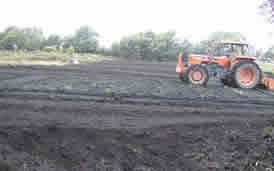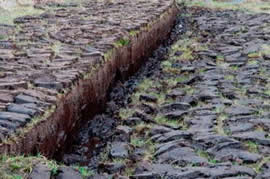Different Types of Soils
Key Difference: Soils are mainly classified on the basis of their nature and composition. There are many different types of soils like – black soil, red soil, laterite soil, alluvial soil, mountain soil, etc. Colors of soils mainly depend upon their composition.
Soil is the layer which is found loosely covering the surface of the Earth. It is a complex mixture of sand and organic material. It is usually formed by the fine rock material which is derived from breaking of the rocks by various geographical processes. Another important constituent of soil is the organic remains of decomposed vegetation. Soil is solid but liquid and air is also present between the minute particles of soil.
Different types of soils are –
 Black soil – These soils are also known as black cotton soils. This soil will be usually found in the volcanic regions as it is formed by lava rocks after they undergo a decomposition process. These are black in color and therefore are named as black soil. This black color is due to the presence of iron in it. This soil is rich in iron, magnesia and alumina, but does not have phosphorous, nitrogen and organic matter. They are deep and impermeable, clayey in nature. Wide cracks are seen especially during the dry seasons. Its main component is clay.
Black soil – These soils are also known as black cotton soils. This soil will be usually found in the volcanic regions as it is formed by lava rocks after they undergo a decomposition process. These are black in color and therefore are named as black soil. This black color is due to the presence of iron in it. This soil is rich in iron, magnesia and alumina, but does not have phosphorous, nitrogen and organic matter. They are deep and impermeable, clayey in nature. Wide cracks are seen especially during the dry seasons. Its main component is clay.
 Red soil – Red soils are found in regions with warm, moderate and moist climates. This soil is mainly formed due to crumbling and weathering. These soils contain good amount of iron, whereas mostly they lack phosphoric acid, organic matter and nitrogenous material. It is not good at all in retaining moisture and is little acidic in nature. It is sandy and not clayey like black soil.
Red soil – Red soils are found in regions with warm, moderate and moist climates. This soil is mainly formed due to crumbling and weathering. These soils contain good amount of iron, whereas mostly they lack phosphoric acid, organic matter and nitrogenous material. It is not good at all in retaining moisture and is little acidic in nature. It is sandy and not clayey like black soil.
 Laterite soil – The word laterite is derived from the Latin word meaning brick. This soil contains high amount of iron and Aluminium oxide. It is a highly weathered red soil which is found in areas with tropical to moderate climate. They are generally found beneath surface of wide grasslands or forest clearings in areas getting good amount of rainfall. The color ranges from red to black, depending upon the quantity of iron oxide in it. It gets harder when exposed to air. These are used in the construction of the buildings. It can be referred to as porous clay.
Laterite soil – The word laterite is derived from the Latin word meaning brick. This soil contains high amount of iron and Aluminium oxide. It is a highly weathered red soil which is found in areas with tropical to moderate climate. They are generally found beneath surface of wide grasslands or forest clearings in areas getting good amount of rainfall. The color ranges from red to black, depending upon the quantity of iron oxide in it. It gets harder when exposed to air. These are used in the construction of the buildings. It can be referred to as porous clay.
 Alluvial soil – These soils get deposited by running water and usually develop in a flood plain or delta. It consists of clay, silt, sand, gravel and other materials which get accumulated by running water. Color of these soils differs from light grey to ash grey. They are sandy to silty loam in context to texture. These soils are good for irrigation and therefore cultivation of many crops can take place in these soils.
Alluvial soil – These soils get deposited by running water and usually develop in a flood plain or delta. It consists of clay, silt, sand, gravel and other materials which get accumulated by running water. Color of these soils differs from light grey to ash grey. They are sandy to silty loam in context to texture. These soils are good for irrigation and therefore cultivation of many crops can take place in these soils.
 Desert soil – This soil belong to the region with arid climate. These soils usually lacks organic matter and if it is present then only in a little amount. They are sandy or rocky in texture. Due to the arid climates and extremely low rainfall, these soils are only able to support little vegetation. This soil contains soluble salts. They are developed by mechanical disintegration and deposition by the wind. These are coarsy and contain very low moisture.
Desert soil – This soil belong to the region with arid climate. These soils usually lacks organic matter and if it is present then only in a little amount. They are sandy or rocky in texture. Due to the arid climates and extremely low rainfall, these soils are only able to support little vegetation. This soil contains soluble salts. They are developed by mechanical disintegration and deposition by the wind. These are coarsy and contain very low moisture.
 Mountain Soil – These soils belong to hill slopes and valleys. These are usually formed when organic matter of the forest settles down. It is quiet rich in humus but lacks Potash and lime. This soil is composed of clay, sand and silt and tends to be rich in moisture. However, the texture may vary from rocky to sandy. These are susceptible to soil erosion as top soil is removed when rains occur heavily in the steep slopes. They are not fertile in nature. They are coarse in texture.
Mountain Soil – These soils belong to hill slopes and valleys. These are usually formed when organic matter of the forest settles down. It is quiet rich in humus but lacks Potash and lime. This soil is composed of clay, sand and silt and tends to be rich in moisture. However, the texture may vary from rocky to sandy. These are susceptible to soil erosion as top soil is removed when rains occur heavily in the steep slopes. They are not fertile in nature. They are coarse in texture.
 Saline and Alkaline soil – Saline soils are formed when soil accumulate in soil and groundwater and by the marine saltwater flooding the land. Slats may also get dissolved in the soil due to chemical weathering of rocks. In case the drainage is not proper, salt remains in the surface and not reaches to the root zone. Saline soils have a large good amount of natural soluble salts mainly comparison of chlorides, sulphates and carbonates of calcium, sodium and magnesium. In alkali souis, pH is more than 8.5.
Saline and Alkaline soil – Saline soils are formed when soil accumulate in soil and groundwater and by the marine saltwater flooding the land. Slats may also get dissolved in the soil due to chemical weathering of rocks. In case the drainage is not proper, salt remains in the surface and not reaches to the root zone. Saline soils have a large good amount of natural soluble salts mainly comparison of chlorides, sulphates and carbonates of calcium, sodium and magnesium. In alkali souis, pH is more than 8.5.
 Peaty and Marshy Soil – Peaty soils are found in regions with humid climate. It appears black in color. Peaty soils are developed when organic matter deposits in the soil in excessive quantity. During the rainy season these soils are submerged under water and therefore are suitable for paddy cultivation. Marshy soils are usually found in the coastal regions close to the sea or delta.
Peaty and Marshy Soil – Peaty soils are found in regions with humid climate. It appears black in color. Peaty soils are developed when organic matter deposits in the soil in excessive quantity. During the rainy season these soils are submerged under water and therefore are suitable for paddy cultivation. Marshy soils are usually found in the coastal regions close to the sea or delta.
Image Courtesy: board.classifieds1000.com, danalbrecht.com, bharatdiscovery.org, panoramio.com, projectpast.org, supersoil.com.au, akasha.wsu.edu









Add new comment